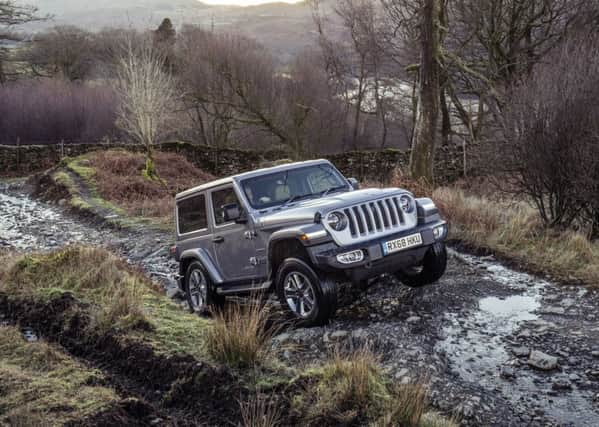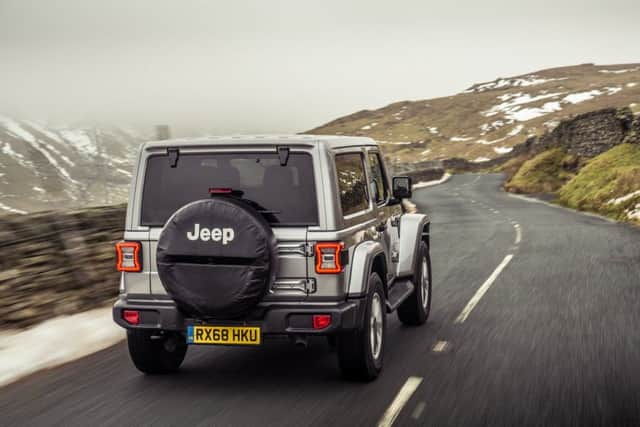Review: The Jeep Wrangler


You can still find all this in today’s Wrangler. Its origins are unmistakable with that body profile, open wings, vertical slotted grille and round headlamps. That post-war Land-Rover had a similar descent but without modernisation the latter-day Defender became unfit to sell in world markets. Air bags? Not even one, but it could still rough it with the best.
A new Defender is going through the marketing hype deemed essential to inflate our passions. It will be in the next James Bond film (don’t smirk at the front) and some time will be on sale at prices which make some in the farming community gasp.
Advertisement
Hide AdAdvertisement
Hide AdWranglers ain’t cheap either. The “cheapest” short, two-door Sport model, which seats four, is 45 quid short of forty grand. The better equipped Sahara tested here is £44,955. The plusher Overland is £47,255. The Rubicon, which has advanced off-roading ability and even tougher axles, is £47,955. A longer and more practical four-door body seating five costs an additional £1,500 and is recommended if you don’t want to upset your rear passengers by asking them to squeeze past the front seats. The format includes side steps and a tailgate with a lift-up rear window.


The engines are now a 197bhp 2.2-litre high torque turbo diesel and a 268bhp 2-litre turbo petrol with slightly lower torque. Gearboxes are eight-speed automatic, with manual selection for all-wheel-drive in high and low ratios. The Wrangler has been kept up to date by Jeep and this latest one is bristling with the driver aids familiar in a contemporary car in a shape we still recognise. A £1,300 pack brought sandy leather seats, heated in the front, keyless operation, a liner for the detachable roof, blind spot mirrors and rear cross traffic alert.
My money broker (well, not mine exactly) has a much older and smaller Wrangler with a 2.5 petrol engine and was impressed with the acceleration of the test car. So was I. The 0-60mph time is around seven seconds – which would match a hot hatchback but watch out for corners and braking.
Off road, if you can cope, then so can your Wrangler. It can complete the Rubicon Trail, an old gold miners’ route in northern California. Done it, got the badge. I need no further convincing. www.rubicontrail.com
Wranglers get rave reviews from these off-road promotional drives but most owners will not do that with their Wrangler. Jeep says it is an everyday car so that’s what we did, in the petrol-powered Wrangler Sahara.
While it is tolerably steady on good roads, it will pitch and lurch on topsy-turvy country single track. It ran quietly on all-season 255/70/18 Bridgestone Dueller tyres. The high ride raises its centre of gravity and don’t be surprised if sudden changes of direction make it wiggle. The Wrangler is not a cat.
The roomy front cabin has an information touch-screen, good navigation, speed awareness systems, lots of storage areas and control buttons on the steering wheel. However, in the dark the instrument display reflects in the door mirror unless you minimise the display brightness. Other poor ergonomics include a lack of space for the driver’s left foot, cramped by the massive transmission tunnel, and having to lean over the tunnel to grapple with the stumpy selector for the 4x4 gearbox transfer. Left-hand-drive Wranglers avoid these compromises.
Utility is not forgotten. Forwards visibility is good for off-road positioning. When you get it muddy the floor can be washed and drained. Grab handles make entry and exit safer and there’s a lateral hold-tight bar in front of the passenger. It may be useful.
Advertisement
Hide AdAdvertisement
Hide AdSide-by-side roof panels are easily removed using four sturdy latches. With the right tools and an extra pair of hands you can remove the aluminium side and back doors, take off the cabin shell and fold down the windscreen. The cockpit remains protected by a full roll cage. Note that in this stripped state the Wrangler will not be road legal but it will be fun on the trail.
Verdict: Nothing like it.